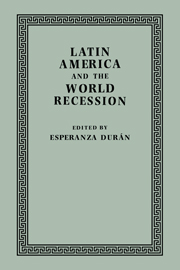Book contents
- Frontmatter
- Contents
- Contributors
- Preface
- 1 The Political Setting: ‘Business as Usual’ or a New Departure?
- Part One The Global Perspective
- Part Two Case Studies
- 5 Brazil's Foreign Debt: The National Debate
- 6 Mexico: Learning to Live with the Crisis
- 7 The Rise and Fall of the Chilean Economic Miracle
- 8 Venezuela: The Oil Boom and the Debt Crisis
- 9 World Recession and Central American Depression: Lessons from the 1930s for the 1980s
- 10 Conclusion
- Index
9 - World Recession and Central American Depression: Lessons from the 1930s for the 1980s
Published online by Cambridge University Press: 05 February 2012
- Frontmatter
- Contents
- Contributors
- Preface
- 1 The Political Setting: ‘Business as Usual’ or a New Departure?
- Part One The Global Perspective
- Part Two Case Studies
- 5 Brazil's Foreign Debt: The National Debate
- 6 Mexico: Learning to Live with the Crisis
- 7 The Rise and Fall of the Chilean Economic Miracle
- 8 Venezuela: The Oil Boom and the Debt Crisis
- 9 World Recession and Central American Depression: Lessons from the 1930s for the 1980s
- 10 Conclusion
- Index
Summary
Introduction
It is undeniable that the present crisis in Central America has more than an economic dimension. The latter, however, remains an important factor not only in explaining the origins of the crisis, but also in accounting for its continuation. Furthermore, the economic aspects of the crisis have received much less attention than the political and geopolitical. I shall therefore concentrate primarily on economic developments in this chapter.
Although the crisis in Central America is a regional one, not all countries have been equally affected. Special factors, for example, account for the collapse of economic activity in Nicaragua in 1978 and 1979, while the precipitate decline in gross domestic product (GDP) in El Salvador after 1978 is singular to that republic.
If we abstract from the special factors, however, we may observe in Central America the unfolding of an economic depression, whose prime cause is the recession of the world economy. This depression is exacerbated in several republics by features peculiar to that country, but the underlying depression (and the trade-cycle model to which it is related) can be analysed separately.
When the trade-cycle model giving birth to the current depression is analysed, it bears a striking resemblance to the 1929 depression in Central America. Indeed, it is interesting to note that 1982 is the first year since 1932 that economic activity declined in all republics at the same time.
- Type
- Chapter
- Information
- Latin America and the World Recession , pp. 130 - 151Publisher: Cambridge University PressPrint publication year: 1985
- 1
- Cited by



